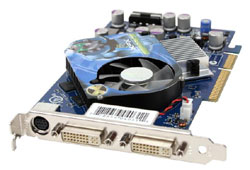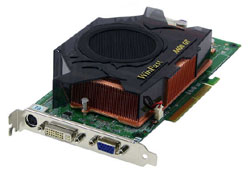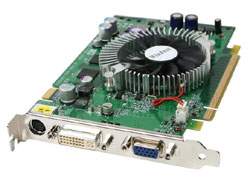Buyer's Guide - Mid-Range, January 2005
by Jarred Walton on January 21, 2005 11:09 AM EST- Posted in
- Guides
Video Card Recommendations
The ups and downs of SLI are becoming more apparent as time passes. There have been some reports of general flakiness with SLI setups, particularly if you're using the DVI connection of your graphics card. Applications ("games" in reality, as we're not aware of any optimizations for non-gaming programs) require hard-coded driver support in order to use SLI; if NVIDIA hasn't yet profiled a game, SLI systems will render using only one video card. You can still purchase an SLI motherboard, but our recommendations here are concerned with Mid-Range price/performance, and SLI - and particularly high-performance PCIe cards - does not fit well in this price segment. Remember that for Intel, we give the PCIe configuration a full recommendation, but for AMD, we're still hesitant. We'll start with the AGP side of things.
AGP Recommendation
XFX 6600GT AGP 128MB GDDR3Price: $209 Shipped
The selection of 6600GT cards in AGP format is beginning to improve, as is the price. While it may not be the cheapest option available, we like the features that the XFX 6600GT 128MB [RTPE: PVT43AND] brings to the table. Specifically, the dual DVI output is a great inclusion for the future. If you don't have an LCD yet, you can use an adapter to run a standard VGA connection, but for LCD users, you will definitely want to get a DVI capable display and graphics card. The ability to run dual LCD displays - and if you're going to use two displays, we strongly recommend LCDs due to their space saving characteristics - would thus require two DVI ports, or else you would have to run with the lower quality VGA connection on one display. Is it absolutely necessary? No, but for an extra $10, we prefer the capability, just in case. An added benefit is that the XFX is clocked at 500 MHz on both the core and the memory; the official specification for the AGP 6600GT cards has the RAM clocked at 450 MHz, unlike the PCIe models. Granted, with overclocking, you could probably push any of the cards to 500 MHz and even further, but for an out-of-box experience, we like the manufacturer-approved "overclock".
There is one noteable drawback to the XFX card, unfortunately. It is relatively loud. We're not talking FX 5800 Ultra levels, by any means, but it is definitely audible. If you want something quieter and are willing to lose the dual-DVI and factory overclock options, MSI makes a very good 6600GT card that is near-silent in comparison. BFG also makes a good card that includes even more factory overclocking than the XFX, but it costs almost as much as a 6800 card, so unless the price drops to match the other 6600GT cards, it is difficult to recommend.
AGP Alternative
Leadtek A400GT TDH 256MB GDDR3Price: $377 Shipped
If you're truly interested in performance without breaking the bank, the best Mid-Range option to get you there remains with the AGP GeForce 6800GT [RTPE: A400 GT TDH]. The Leadtek cards also include a large, two-slot copper heatsink, which should help to keep the card cool. If you like our above recommendation to get a dual-DVI card where possible, you'll have to spend $30 more to get an XFX card. Lately, XFX has started to make a point of offering dual DVI output on all their cards. They do have some 6800GT cards with a VGA/DVI output for less money, but nearly all of their new cards are now dual-DVI.
For an in-between alternative, the 12 pipeline 6800 cards are also viable. They're not tremendously faster than the 6600GT - in fact, in terms of pixel processing power, it's basically a tie between the two chips - but they do have a 256-bit memory interface that can help out quite a bit in certain applications. For a price that's pretty much right in line with the performance increase/decrease relative to the 6600GT and the 6800GT, the BFG 6800 OC [RTPE: BFGR6800] would be our pick. Depending on your location, it can be had for as little as $259.
PCIe Recommendation
Leadtek Winfast PX6600GT TDH PCIe 128MBPrice: $190 Shipped
If you want to get a PCI Express system, the only reasonably mid-range option is the 6600GT. The 6800 PCIe cards carry a large price premium at present, so they remain high-end options. We recommend that anyone who is looking at the 6600GT cards should read our 6600GT roundup. One of the key stumbling blocks for a lot of the cards was a poorly mounted HSF, which could cause problems if you swap hardware a lot or move your computer around much. Basically, the advice for most of the 6600GT cards is "handle with care". Our recommendation goes to the Leadtek 6600GT [RTPE: PX6600GT TDH], the Gold Editor's Choice card from the roundup. The card runs cool and quiet, overclocking is decent - about in line with most of the other cards - and the HSF is mounted securely. Again, dual-DVI is an option with the XFX model [RTPE: PVT43GND], which was our runner-up Silver Editor's Choice. It wasn't without issues, noise being one of them, but there aren't many options that we're comfortable recommending at this point which have dual-DVI.
Despite all of our talk about SLI not offering much, it is an option some will like. It doesn't save you much over the long term relative to AGP, but it's better than nothing. We're really looking forward to the actual retail availability of ATI's X800 and X800XL cards, which are supposed to target prices of $199 and $299 respectively. It may take two months for them to actually reach that price, if the trends of the past few months continue, but they do bring some needed competition to the low- to mid-range PCIe segment. Serious ATI fans who are looking for good value really have only one option right now, the X700 Pro [RTPE: X700 Pro]. While the 256 MB of RAM might seem attractive, it really doesn't help that much and we would prefer a faster core and RAM rather than more RAM running at slower speeds. The X700 XT, unfortunately, has been removed from ATI's lineup, so you'll have to wait for the X800. For top PCIe performance, the 6800GT PCIe card with an eye towards SLI would make sense, but the $475 price point per card is $100 more than its AGP counterpart and well into the high-end segment.













46 Comments
View All Comments
JarredWalton - Friday, January 21, 2005 - link
Rand - That doesn't surprise me too much, given our recent article showing that the NF4 Ultra and NF4 SLI are the same chip with a tweaked package. I would guess there's a reasonable chance the NF4 4X is the same as well, with other modifications to the package. As far as I know, what I put about their difference is the "official" NVIDIA stance. If the 4X is just the "validated" version... well, not a big deal, really. I'll modify the text a bit to reflect this.KristopherKubicki - Friday, January 21, 2005 - link
N3cr0: The nForce4 board you mentioned is not shipping yet.Kristopher
Jep4444 - Friday, January 21, 2005 - link
I think the Asus A8V Deluxe would of been a better motherboard recomendation than the MSI K8N Neo2 Platinum. The Asus board is pretty much the best 939 AGP board out and it costs less than the MSI aswell.Avalon - Friday, January 21, 2005 - link
'Samsung calls the 997DF a "perfectly visually flat" tube. What they really mean is that the surface of the glass is perfectly flat, but the inside of the glass is very slightly curved. Most people will never notice it, but we feel that in the interest of full disclosure, it should be mentioned'Yes. Thank you for pointing that out, Jared. I purchased this monitor about a month ago, and noticed it right upon powering it up. No matter how much you adjust the geometry, there is always a slight curve. I was so angry at one point I was either going to hit it with a bat or return it. Now I've just learned to deal with it, and I'm no longer really bothered by it.
Rand - Friday, January 21, 2005 - link
Slight addendum to my above post-I just tried nVidia's hardware firewall.. it's working fine.Apparently that also runs on the basic nForce4.
Rand - Friday, January 21, 2005 - link
Slight addendum to my above post-I just tried nVidia's hardware firewall.. it's working fine.Apparently that also runs on the basic nForce4.
Rand - Friday, January 21, 2005 - link
"The difference, if you recall, is that the Ultra has an unlocked HyperTransport multiplier and will generally offer more in the way of overclocking, while the 4X is locked at a 4X HyperTransport multiplier (800 MHz)."I believe that's since been proven false.
There are a couple threads in the Motherboards forum about overclocking on said board, and I haven't seen anyone comment on any difficulties adjusting the HTT.
My own board is running at 300x3 HTT (900MHz HTT) right now. (Adjustable from 2-5X), though it did need +0.2V to the chipset to run stable at 1000HTT.
The differences right now between the NF4 and NF4 Ultra would appear to be 3Gb/s SATA vs. 1.5Gb/s SATA, and official support for 1000HTT vs 800HTT.
As well as not supporting nVidia's firewall.
geogecko - Friday, January 21, 2005 - link
Where are all the nForce4 Ultra (non-SLI) boards? Really looking forward to ASUS A8N-E Premium, but no news, except that some have said this board will never exist?!Gage8 - Friday, January 21, 2005 - link
I don't know, this guide just confirmed for me that now is not the time to buy if you want stability and upgradability (new word?).Nforce2 taught me not to buy revision 1.x...so lesson learned, bring on Nforce4 revision 2.x.
N3cr0 - Friday, January 21, 2005 - link
Just curious why the MSI K8N Neo4 Platinum/SLI wasn't put in as an SLI board for the AMD choices. It seems to be lower price then the Asus board. I'm going to get one of the two boards and can't really figure out what the differences are aside from some networking items. (That and the HyperTransport which I dont get at all)